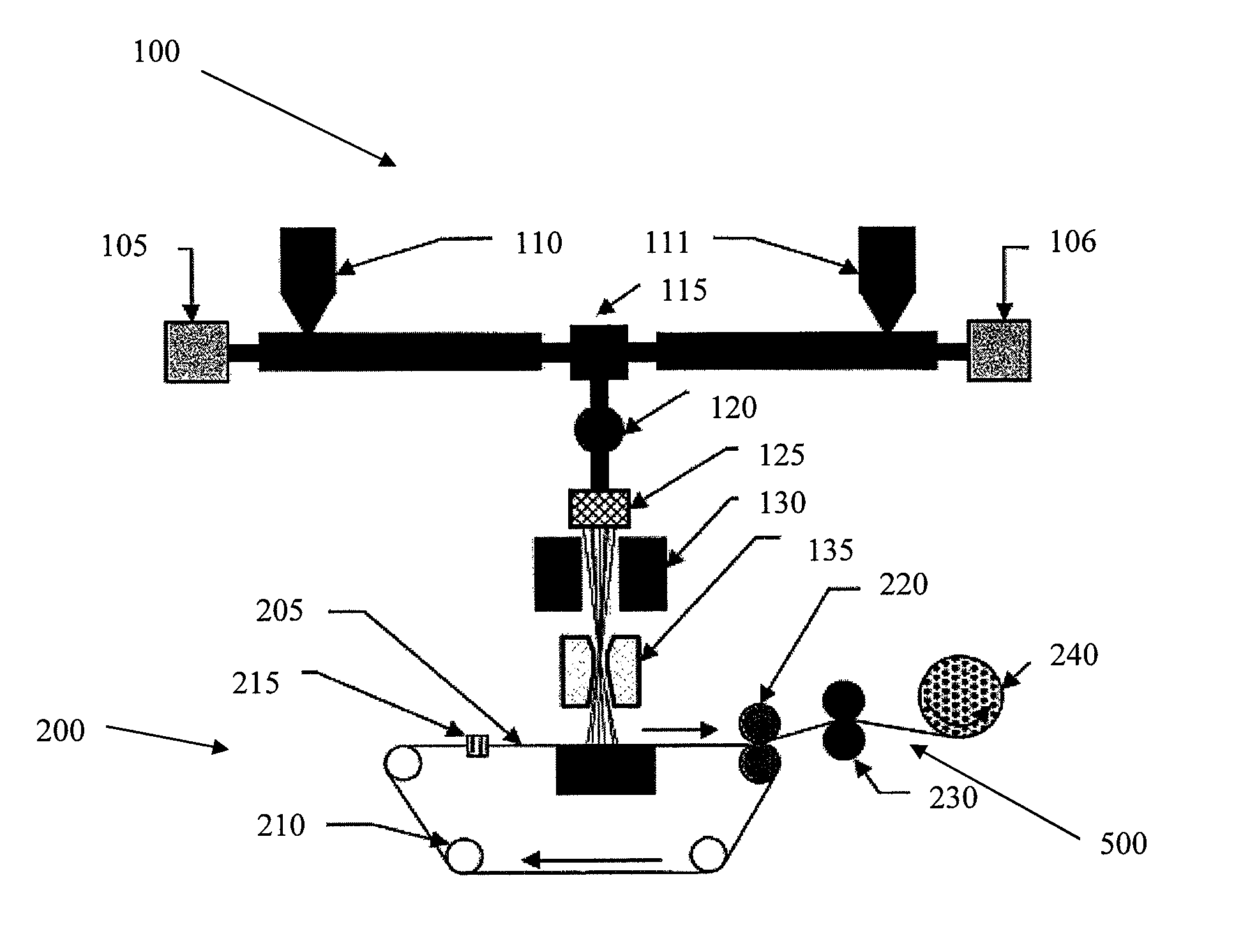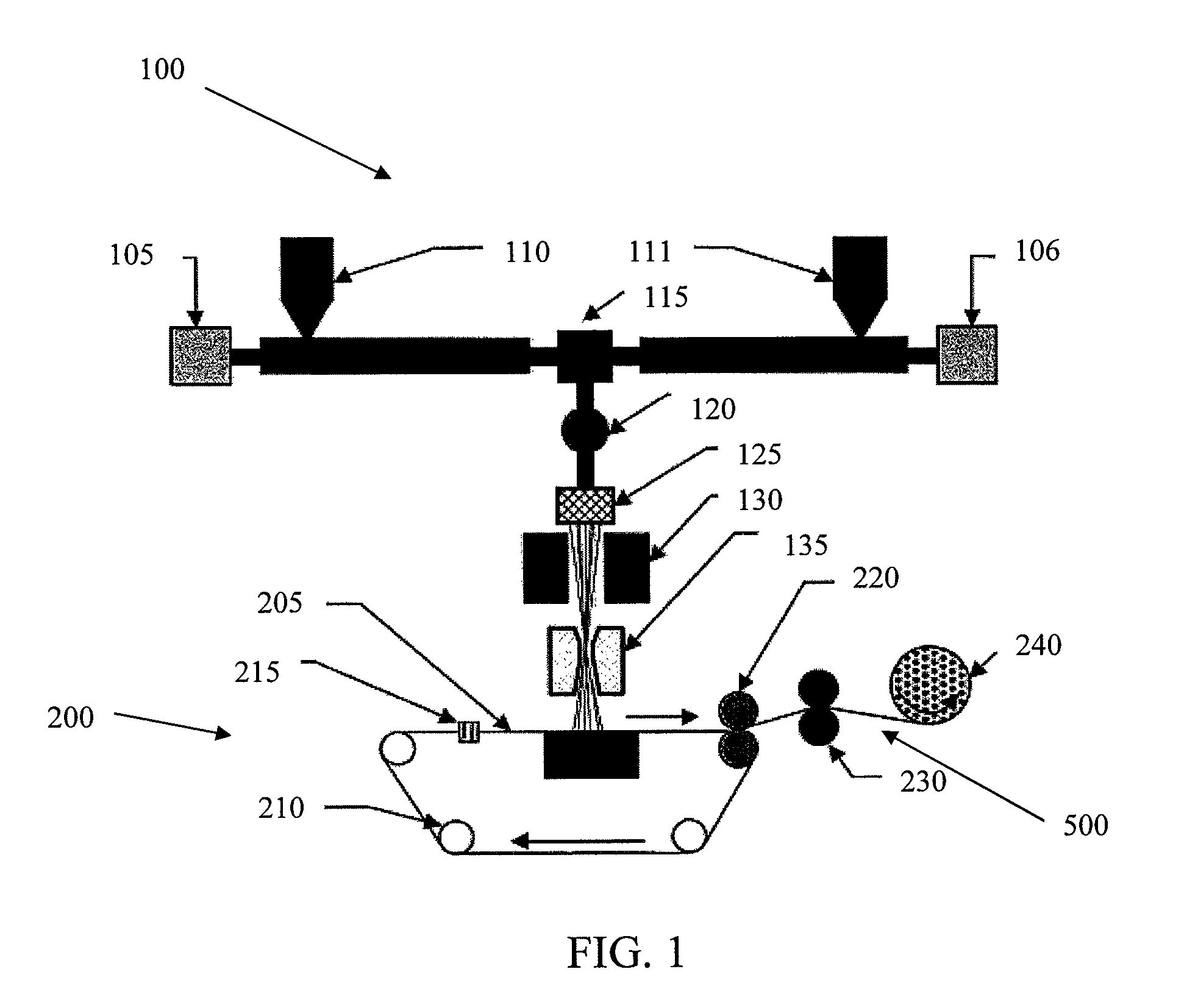Micro and nanofiber nonwoven spunbonded fabric
a non-woven, nanofiber technology, applied in the field of nanofibers and fabrics, can solve the problems of low productivity of the process, inability to easily produce nanofiber webs, and limited number of polymers in the process, so as to improve mechanical properties, reduce the effect of base weight and high strength and durability
- Summary
- Abstract
- Description
- Claims
- Application Information
AI Technical Summary
Benefits of technology
Problems solved by technology
Method used
Image
Examples
example 1
Preparation of Spunbond Web
Using Bicomponent Fibers
[0111]Bicomponent I / S fibers were prepared using ULTRAMID® BS 700 nylon-6 polymer (available from BASF) as the island components and PLA as the sea polymer. Polymer properties are provided below in Table 2. The bicomponent fibers were prepared to have 36, 108, 216, or 360 island components using standard spinning methods as described herein and continuously laid on a forming belt to form a nonwoven web. The nonwoven web was hydroentangled at a speed of 30 m / min to form a nonwoven spunbonded fabric. The total hydroentangling energy used was 8000 kJ / kg. The basis weight of the fabric was maintained at 170 g / m2 for all samples. A description of the samples prepared is provided below in Table 3.
[0112]The PLA sea was removed in a winch beck machine by treating the fabric for 10 minutes in a 3% solution of caustic soda in water at a temperature of 100° C. The basis weight of the fabric after removal of 25% of the PLA sea was 140 g / m2. The...
example 2
Crystallinity and Crystalline Orientation
[0115]Wide-angle X-ray scattering (WAXS) profiles of the fibers prepared in Example 1 were obtained by Omni Instrumental X-ray diffractometer with a Be-filtered CuKα radiation source (λ=1.54 Å) generated at 30 kV and 20 mA. The I / S fibers were manually wound in a tightly packed flat layer of parallel fibers onto a holder prior to the examination. The samples were equatorially scanned at the rate 0.2° min−1 from 2θ=10°-35° in the reflection geometry for a count time of 2.5 seconds. Intensity curves of the equatorial scans were resolved into peaks at 2θ=22° for nylon-6 fibers and at 2θ=16.5° for PLA fibers. To calculate Herrman's orientation functions, transmission scans of the samples at the rate of 0.5° min−1 and count time 1 second at fixed diffraction angles were performed.
[0116]The relationships between the number of islands and crystallinity of the nylon-6 and PLA phases in the I / S fibers are illustrated in FIG. 16a and FIG. 16b, respecti...
example 3
Fiber Mechanical Properties
Before and After PLA Sea Removal
[0119]Tenacity and initial modulus properties of the composite I / S fibers prepared according to Example 1 (without removing PLA) are illustrated in FIG. 18 and FIG. 19, respectively. With the exception of tenacity for the filaments with 25% nylon-6, all fibers containing 360 islands showed the highest tenacity and initial modulus. Overall, the I / S fibers demonstrated performance similar to that of PLA homo-component filaments, which had a lower elongation to break than 100% nylon-6 fibers. Thus, the I / S fibers tended to exhibit tensile properties similar to those of 100% PLA fibers. The degree of entangling of the multicomponent fibers can be seen in FIG. 20 and FIG. 21. FIG. 20 provides an SEM image of a hydroentangled fabric before removal of the sea component prepared according to the invention having 216 island components. FIG. 21 provides an SEM image of a hydroentangled fabric before removal of the sea component prepar...
PUM
| Property | Measurement | Unit |
|---|---|---|
| diameter | aaaaa | aaaaa |
| diameter | aaaaa | aaaaa |
| diameter | aaaaa | aaaaa |
Abstract
Description
Claims
Application Information
 Login to View More
Login to View More - R&D
- Intellectual Property
- Life Sciences
- Materials
- Tech Scout
- Unparalleled Data Quality
- Higher Quality Content
- 60% Fewer Hallucinations
Browse by: Latest US Patents, China's latest patents, Technical Efficacy Thesaurus, Application Domain, Technology Topic, Popular Technical Reports.
© 2025 PatSnap. All rights reserved.Legal|Privacy policy|Modern Slavery Act Transparency Statement|Sitemap|About US| Contact US: help@patsnap.com



